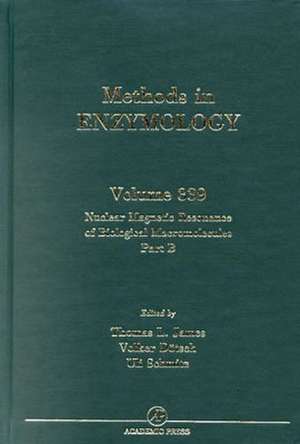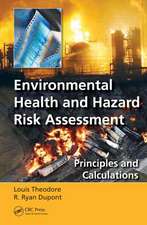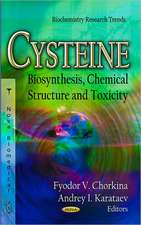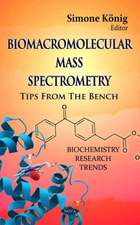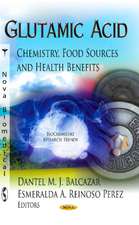Nuclear Magnetic Resonance of Biological Macromolecules, Part B: Methods in Enzymology, cartea 339
Thomas L. James, Volker Dotsch, Uli Schmitzen Limba Engleză Hardback – 12 iul 2001
Din seria Methods in Enzymology
- 32%
 Preț: 802.54 lei
Preț: 802.54 lei - 23%
 Preț: 461.36 lei
Preț: 461.36 lei - 23%
 Preț: 460.60 lei
Preț: 460.60 lei - 23%
 Preț: 439.86 lei
Preț: 439.86 lei - 23%
 Preț: 448.15 lei
Preț: 448.15 lei - 23%
 Preț: 451.42 lei
Preț: 451.42 lei - 23%
 Preț: 445.18 lei
Preț: 445.18 lei - 5%
 Preț: 557.15 lei
Preț: 557.15 lei - 23%
 Preț: 450.67 lei
Preț: 450.67 lei - 23%
 Preț: 446.23 lei
Preț: 446.23 lei - 23%
 Preț: 435.87 lei
Preț: 435.87 lei - 23%
 Preț: 445.94 lei
Preț: 445.94 lei - 23%
 Preț: 459.55 lei
Preț: 459.55 lei - 23%
 Preț: 460.02 lei
Preț: 460.02 lei - 23%
 Preț: 456.61 lei
Preț: 456.61 lei - 23%
 Preț: 450.54 lei
Preț: 450.54 lei - 23%
 Preț: 453.47 lei
Preț: 453.47 lei - 5%
 Preț: 565.37 lei
Preț: 565.37 lei - 23%
 Preț: 450.67 lei
Preț: 450.67 lei - 23%
 Preț: 464.33 lei
Preț: 464.33 lei - 23%
 Preț: 441.49 lei
Preț: 441.49 lei - 23%
 Preț: 447.44 lei
Preț: 447.44 lei - 23%
 Preț: 459.13 lei
Preț: 459.13 lei - 23%
 Preț: 450.38 lei
Preț: 450.38 lei - 23%
 Preț: 445.80 lei
Preț: 445.80 lei - 23%
 Preț: 445.35 lei
Preț: 445.35 lei - 23%
 Preț: 442.53 lei
Preț: 442.53 lei - 23%
 Preț: 450.38 lei
Preț: 450.38 lei - 23%
 Preț: 448.60 lei
Preț: 448.60 lei - 23%
 Preț: 447.57 lei
Preț: 447.57 lei - 23%
 Preț: 458.97 lei
Preț: 458.97 lei - 23%
 Preț: 440.90 lei
Preț: 440.90 lei - 23%
 Preț: 448.15 lei
Preț: 448.15 lei - 23%
 Preț: 466.84 lei
Preț: 466.84 lei - 23%
 Preț: 451.42 lei
Preț: 451.42 lei - 23%
 Preț: 453.64 lei
Preț: 453.64 lei - 23%
 Preț: 459.13 lei
Preț: 459.13 lei - 23%
 Preț: 457.49 lei
Preț: 457.49 lei - 23%
 Preț: 447.44 lei
Preț: 447.44 lei - 5%
 Preț: 561.34 lei
Preț: 561.34 lei - 23%
 Preț: 447.57 lei
Preț: 447.57 lei - 23%
 Preț: 453.35 lei
Preț: 453.35 lei - 23%
 Preț: 441.95 lei
Preț: 441.95 lei - 23%
 Preț: 450.38 lei
Preț: 450.38 lei - 23%
 Preț: 449.19 lei
Preț: 449.19 lei - 23%
 Preț: 456.02 lei
Preț: 456.02 lei - 23%
 Preț: 455.11 lei
Preț: 455.11 lei - 23%
 Preț: 455.87 lei
Preț: 455.87 lei - 23%
 Preț: 451.12 lei
Preț: 451.12 lei
Preț: 1241.38 lei
Preț vechi: 1700.53 lei
-27% Nou
Puncte Express: 1862
Preț estimativ în valută:
237.56€ • 246.52$ • 198.56£
237.56€ • 246.52$ • 198.56£
Carte tipărită la comandă
Livrare economică 17-31 martie
Preluare comenzi: 021 569.72.76
Specificații
ISBN-13: 9780121822408
ISBN-10: 0121822400
Pagini: 454
Dimensiuni: 152 x 229 x 27 mm
Greutate: 0.83 kg
Editura: ELSEVIER SCIENCE
Seria Methods in Enzymology
ISBN-10: 0121822400
Pagini: 454
Dimensiuni: 152 x 229 x 27 mm
Greutate: 0.83 kg
Editura: ELSEVIER SCIENCE
Seria Methods in Enzymology
Public țintă
Biochemists, biophysicists, molecular biologists, and cell biologists.Cuprins
Section I: Proteins A. Techniques for proteins
[1]: Physiological Conditions and Practicality for Protein Nuclear Magnetic Resonance Spectroscopy: Experimental Methodologies and Theoretical Background
[2]: Optimization of Protein Solubility and Stability for Protein Nuclear Magnetic Resonance
[3]: Segmental Isotopic Labeling Using Expressed Protein Ligation
[4]: High-Resolution Nuclear Magnetic Resonance of Encapsulated Proteins Dissolved in Low Viscosity Fluids
[5]: Automated Assignment of Ambiguous Nuclear Overhauser Effects with ARIA
[6]: Automatic Determination of Protein Backbone Resonance Assignments from Triple Resonance Nuclear Magnetic Resonance Data
[7]: Nuclear Magnetic Resonance Relaxation in Determination of Residue-Specific 15N Chemical Shift Tensors in Proteins in Solution: Protein Dynamics, Structure, and Applications of Transverse Relaxation Optimized Spectroscopy
[8]: Dipolar Couplings in Macromolecular Structure Determination
[9]: Nuclear Magnetic Resonance Methods for High Molecular Weight Proteins: A Study Involving a Complex of Maltose Binding Protein and β-Cyclodextrin
[10]: Nuclear Magnetic Resonance Methods for Quantifying Microsecond-to-Millisecond Motions in Biological Macromolecules
Section I: Proteins B. Classes of proteins
[11]: Characterizing Protein-Protein Complexes and Oligomers by Nuclear Magnetic Resonance Spectroscopy
[12]: Nuclear Magnetic Resonance Methods for Elucidation of Structure and Dynamics in Disordered States
[13]: Micellar Systems as Solvents in Peptide and Protein Structure Determination
[14]: Nuclear Magnetic Resonance of Membrane-Associated Peptides and Proteins
[15]: Paramagnetic Probes in Metalloproteins
Section II: Macromolecular complexes
[16]: Protein–DNA Interactions
[17]: Nuclear Magnetic Resonance Methods to Study Structure and Dynamics of RNA–Protein Complexes
[18]: Protein–protein interactions probed by nuclear magnetic resonance spectroscopy
[19]: Solid-State Nuclear Magnetic Resonance Techniques for Structural Studies of Amyloid Fibrils
Author Index
Subject Index
[1]: Physiological Conditions and Practicality for Protein Nuclear Magnetic Resonance Spectroscopy: Experimental Methodologies and Theoretical Background
[2]: Optimization of Protein Solubility and Stability for Protein Nuclear Magnetic Resonance
[3]: Segmental Isotopic Labeling Using Expressed Protein Ligation
[4]: High-Resolution Nuclear Magnetic Resonance of Encapsulated Proteins Dissolved in Low Viscosity Fluids
[5]: Automated Assignment of Ambiguous Nuclear Overhauser Effects with ARIA
[6]: Automatic Determination of Protein Backbone Resonance Assignments from Triple Resonance Nuclear Magnetic Resonance Data
[7]: Nuclear Magnetic Resonance Relaxation in Determination of Residue-Specific 15N Chemical Shift Tensors in Proteins in Solution: Protein Dynamics, Structure, and Applications of Transverse Relaxation Optimized Spectroscopy
[8]: Dipolar Couplings in Macromolecular Structure Determination
[9]: Nuclear Magnetic Resonance Methods for High Molecular Weight Proteins: A Study Involving a Complex of Maltose Binding Protein and β-Cyclodextrin
[10]: Nuclear Magnetic Resonance Methods for Quantifying Microsecond-to-Millisecond Motions in Biological Macromolecules
Section I: Proteins B. Classes of proteins
[11]: Characterizing Protein-Protein Complexes and Oligomers by Nuclear Magnetic Resonance Spectroscopy
[12]: Nuclear Magnetic Resonance Methods for Elucidation of Structure and Dynamics in Disordered States
[13]: Micellar Systems as Solvents in Peptide and Protein Structure Determination
[14]: Nuclear Magnetic Resonance of Membrane-Associated Peptides and Proteins
[15]: Paramagnetic Probes in Metalloproteins
Section II: Macromolecular complexes
[16]: Protein–DNA Interactions
[17]: Nuclear Magnetic Resonance Methods to Study Structure and Dynamics of RNA–Protein Complexes
[18]: Protein–protein interactions probed by nuclear magnetic resonance spectroscopy
[19]: Solid-State Nuclear Magnetic Resonance Techniques for Structural Studies of Amyloid Fibrils
Author Index
Subject Index
